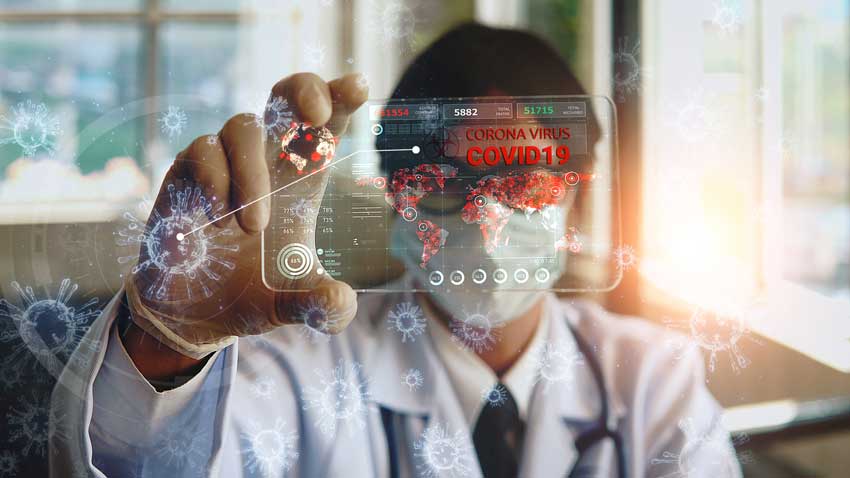Since the discovery of COVID-19 and its rapid rise to pandemic status, cutting-edge technologies have been deployed to help fight the deadly virus. Healthcare providers, researchers and other professionals are using artificial intelligence (AI), drones, robots and super computers — all powered by cloud computing — to save lives and beat back the virus.
The use of existing and emerging technologies often raises concerns about privacy. “Tracking entire populations to combat the pandemic now could open the doors to more invasive forms of government snooping later,” wrote Natasha Singer and Choe Sang-Hun in a late March New York Times article titled As Coronavirus Surveillance Escalates, Personal Privacy Plummet. As an example, during the mandatory lockdown in the northern Italian region of Lombardy, authorities tracked mobile phone data and determined about 40% of the population was moving around too much. The article argued that uses like this during pandemics may be necessary, but it’s critical to understand the long-term impact of eroding people’s right to privacy in a world increasingly augmented by digital technologies.
When authorities pivoted to fight the rapid escalation of coronavirus cases in Wuhan, China, many in the country’s technology industry put their products into action. SenseTime, for example, shifted its AI expertise to help tackle the challenges born from COVID-19.
“Technology companies in China, including ourselves, are deploying different solutions to minimize the spread of the virus, support the frontline medical staff and help everyday people get back to some level of normalcy,” a SenseTime spokesperson told The Forecast.
AI Helps Pinpoint Coronavirus Cases
In an effort to slow the spread of the illness in the hardest hit regions in China, SenseTime’s body temperature detection software uses AI to screen for potential coronavirus carriers in public spaces. Because fevers are one of the primary symptoms of COVID-19, SenseTime can detect elevated temperatures with infrared cameras and AI algorithms. Deployed in subways, schools and community centers in Beijing and beyond, the technology alerts staff to feverish patients, making screenings more efficient while also minimizing the risk of contagion.

AI is also being used effectively at Infervision, a Beijing-based company that’s working to streamline medical care within hospitals.
“We are focused 100% on the use of AI in medical imaging and research,” said Tony Gevo, vice president of sales and marketing in North America for Infervision.
Infervision’s coronavirus detector reads computed tomography (CT) lung scans for visual signs of pneumonia that often are associated with this particular virus strain.
“When the outbreak began in Wuhan, we put a team of data scientists on the ground and basically embedded them with the clinicians to gather data and find out what was different about COVID-19-induced pneumonia compared to regular pneumonia,” Gevo said. “What we found are striking differences. Our software is built to very rapidly and accurately recognize the unique characteristics of pneumonia caused by COVID-19.”
According to Gevo, Infervision’s software has been used to review more than 32,000 coronavirus cases and is now in 34 hospitals, including facilities in Japan and Wuhan, China, where the virus originated. Infervision is seeking emergency use authorization from the U.S. Food and Drug Administration (FDA) to begin using the product in the United States.
“The cloud is where the image processing takes place,” Gevo said. “The file is transmitted to the cloud platform, it’s read, the results are created and then [they’re] sent back to the site.”
The company’s cloud-enabled technology is faster and more accurate than other coronavirus tests, which often take hours or days. As a result, it increases efficiency in overwhelmed hospitals and helps doctors better triage patients.
“It’s a tool that certainly doesn’t replace physicians, but it makes things more efficient. Instead of taking 25 minutes to read a chest CT, it may take 2 minutes,” Gevo continued. “In many parts of the world, there’s just not enough radiologists. A hospital during normal times might have somebody read 10 to 15 chest CTs a day; during this epidemic they may have to read 1,500 CTs.”
Drones Attempt to Prevent Disease Spread
Drones are also helping to combat the spread of COVID-19. Drone manufacturer MMCUAV, for example, has used unmanned aerial vehicles (UAVs) throughout China to conduct remote surveillance, identifying ill citizens through thermal imagery. UAVs also are used to spray chemical disinfectants.
“We’re using long-endurance and large-payload drones that can fly 60 to 70 minutes and can carry 10 kilograms of payload, including a 40x-zoom camera and a speaker,” said Gary Gu, director of business development and marketing at MMCUAV. “A drone can fly for long distances to patrol and monitor a city.”

To curb the domestic spread of COVID-19, the Chinese government placed regions of China under complete lockdown. In partnership with local governments and police in 12 cities, MMCUAV used drones to remotely scan streets for pedestrians in violation of the lockdown, who were told via speaker to go home.
Gu said there’s a ground station where policemen on duty can see images from the drones. A 4G LTE module streams video images from the ground station to a command center.
“The cloud is very important for the surveillance mission because people in the field might not understand the importance of an image, but people in the command center can have more experience with that,” Gu explained. “It’s important for those people who have more experience to see what’s happening.”
Because drones are flown remotely, fewer people have to be outside, which increases efficiency and decreases the risk of possible exposure for law enforcement. The technology has been especially useful in rural regions of China.
“It’s getting much better in China now, so we are no longer doing these tasks,” reported Gu, who said the company is now fielding requests for similar services from countries that are still working to control the coronavirus, like India and South Korea. BBC News reported that the Spanish police also have been using speakers onboard drones to keep people inside while the Financial Times said police in California are looking to do the same.
Robots in Medicine Help Patients and Healthcare Workers
Robots are helping limit person-to-person contact during this deadly pandemic. Chinese start-up PuduTech, for instance, leverages robots to deliver supplies to hospitals and their patients.

“By deploying the robots to deliver food or other supplies to quarantined people, human-to-human contact is limited, which both avoids potential spreading of the disease and removes people who might normally be performing that task from repeated high-risk encounters,” said Ben Zheng, PuduTech’s marketing director.
According to Zheng, PuduTech’s product, PuduBot, is now in approximately 100 hospitals across South Korea and mainland China, including in Wuhan. It delivers medicine, food, masks and more – typically over short distances.
“PuduTech has independently researched and developed its own robot positioning and navigating technologies based on a multi-sensor strategy,” Zheng said.
Robots navigate using a proprietary PuduSLAM algorithm that integrates data from multiple sensors: lidar, a vision camera with a sensor pointing directly up, and two depth cameras located in the lower part of the robot.
“Pudu robots are using our own cloud service, PuduCloud, which provides visualized business management, automatic operation and cloud-based intelligent service,” Zheng said.
Supercomputers Seek a Cure
The world’s fastest supercomputer, IBM’s Summit, recently ran thousands of simulations to identify the best drug compounds to treat the virus, according to CNN. Forbes reported that some of the largest companies in China, including Alibaba, Tencent, DiDi and Huawei, are donating their cloud computing resources to assist global research institutions in developing a cure for COVID-19.
Researchers will be able to utilize these platforms to accelerate the gene sequencing process, conduct speedy data analysis and run faster calculations than would otherwise be possible using slower, more traditional computers. Collectively, these companies are hoping to fast-track the development of an effective treatment and vaccine.
As the world grapples with a dangerous, global pandemic, cloud-based technologies are doing their part to help contain, treat and eliminate the novel coronavirus.
Chase Guttman is a contributing writer specializing in drones. He authored the critically acclaimed book The Handbook of Drone Photography. Find him on Twitter @chaseguttman.
© 2020 Nutanix, Inc. All rights reserved. For additional legal information, please go here.


